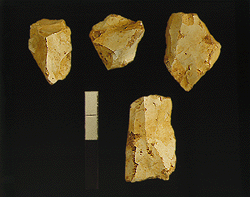 |

Microliths are the tools that characterized the stone industries of the Upper Palaeolithic, the Epipalaeolithic and the Mesolithic periods. The chief raw materials used in their manufacture were flint and obsidian.
|

The geometric microliths can be triangular, trapezoid, rectangular or crescent ("segment de cercle") in shape. Their geometrical form is the result of fine and continuous retouch on one or more edges resulting quite often a truncation. The non geometric microliths are usually points shaped on whole or parts of bladelets. Excavations in Greece at the caves of Franchthi at Hermionid, Theopetra at Trikala and Cyclops at Yioura near Alonnisos have revealed significant collections of microliths. |
 |
 |
 |
 |
 |
 |